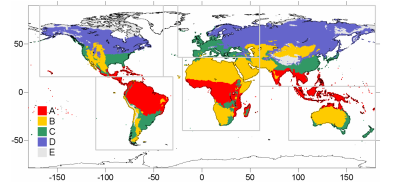The Köppen’s Classification
PDFThe Köppen classification of the climates (Figure 1) is one of the oldest empirical classifications, established between 1900 and 1936. Although very old, it is still widely used; sometimes in a modified form [1]. A botanist by training, Köppen always sought to establish the link between the types of climates and the distribution of vegetation on the globe.

This classification uses 3 criteria of decreasing importance and designated, for each category, by 3 successive letters [2]:
- The first letter, from A to E, represents the main attribute of the climatic category and consequently the main types of climate according to a zonal distribution that takes into account a distribution according to latitudes from the equator to the poles: A: Rainy tropical climates; B: Dry climates; C: Temperate humid climates; D: Subarctic boreal climates; E.: Snowy climates.
- The second letter is mainly associated with the rainfall system, sometimes with temperature. This letter, which can be uppercase or lowercase, corresponds to the first letters of a German word: F: Frost (frost), f: feucht (wet), m: Monsunregen (monsoon rains), S: Steppe, s: Sommertrockenzeit (summer droughts), T: Tundra, W: Wüste (deserts), w: Wintertrockenzeit (winter droughts).
- The third letter refers only to the average temperature: a, b, c, d, h (trocken-heiss: hot and dry) and k (trocken-kalt: cold and dry).
Tableau 1. Major types of Köppen-Geiger climates according to Kottek et al (2006) [Source: Foucault, 2009]
Notes & references
[1] Beck, H. E., et al. (2018). Present and future Köppen-Geiger climate classification maps at 1-km resolution. Scientific data, 5(1), 1-12. https://www.nature.com/articles/sdata2018214
[2] Foucault, A. (2009). Climatology and paleoclimatology. Ed. Dunod (France). 323 p.





